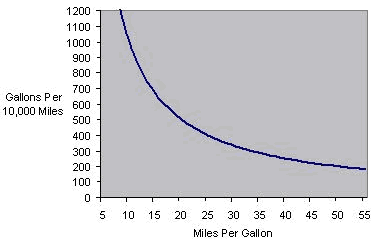While researching the benefit of swapping one of my 21 mpg cars for a 31 mpg Honda Fit, I came across a site called the MPG Illusion. The easiest way to illustrate their point is via a quick quiz.
Pop Quiz
The full quiz and explanation is here. But the very core of the argument can be summed up below. Assuming that both cars are driven 100 miles per week:

Without breaking out the calculator, you might think that having 50 mpg and 10 mpg together might average out to about 30 mpg, beating out the two 20 mpg cars. The problem is that using miles per gallon is not intuitive. Why?
Miles per gallon (MPG) is more useful for things like calculating the range of your vehicle.
Gallons per mile (GPM) would be better for estimating the actual cost of driving your car, since gallons is directly proportional to dollars spent.
Okay, a little math. Getting 10 miles per gallon is the same as saying you use 10 gallons every 100 miles. 20 mpg means 5 gallons every 100 miles. 50 mpg means 2 gallons every 100 miles. So in one week, the Option 1 uses 10 gallons per week. Option 2 uses 12 gallons per week. Option 1 wins!
If you remember gallons = $$, this chart below shows (also from MPG Illusion), the savings you get from going from 10 mpg to 20 mpg is a lot greater than going from 30 mpg to 40 mpg. In fact, going from 16 to 20 mpg can save as much gas as the shift from 31 to 50 mpg.

Higher mpg numbers are still better, but the benefit is diminishing. Going for the hybrid might get you the most “green” points, but you might be getting most of the benefit for a lot less money by simply switching to a more affordable car with a decent mpg bump. Is it almost used Honda Fit time? Run the numbers for yourself at this GPM calculator.
(Does this make the “Cash for Clunkers” program more palatable? I don’t know, they could still raise the minimum improvement amounts.)
Read more about The MPG Illusion: Comparing Fuel Efficiency Can Be Tricky…
No comments:
Post a Comment